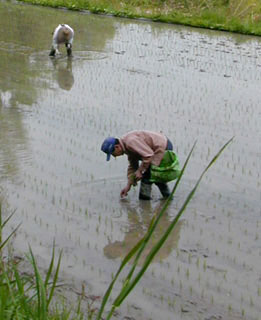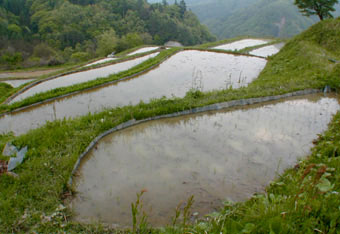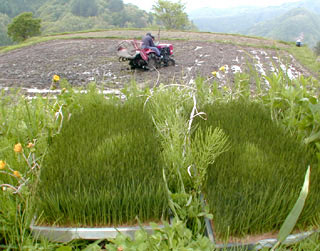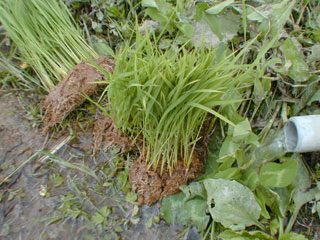Nagano Rice Farmers Plant for Piece of Mind
Sometimes I get nightmares. Many of them center around lost liquor cabinet keys, a lack of small bills for beer vending machines, or cigarettes with filters. But today the nightmare was something much more severe. And what's worse, it was very, very real.
 "Those bastards went and did it," I steamed, gripping my pack firmly in my right fist as I sat in my office chair.
"Those bastards went and did it," I steamed, gripping my pack firmly in my right fist as I sat in my office chair.
"Relax," said junior reporter Junko. "You'll be fine - you didn't even notice the ban for a full two weeks after it was implemented."
"Notice?" I asked. "You know full well I just returned from Nagano where I covered the rice planting story. Now I find this?" I flung the memo in her direction near my doorway in disgust.
Effective immediately, a new newsroom policy shall remove all designated smoking areas and enforce a total smoking ban on all floors as a means of health promotion...
"It is a part of health promotion," she explained. "Passive smoking is seen as hazardous..."
I further tightened my grip, forcing a few bits of tobacco out of the top of the package.
"It wasn't enough for you earth muffins to get the whale burgers taken off the cafeteria menu last month?" I gasped, sweat beads rolling down my back. "Was it??"
She shrugged her shoulders and returned to her desk in the newsroom.
My forehead slammed onto the top of my desk. With my teeth clenched, I pulled my ashtray closer like a mother bear its cub.
As Masanori Kitahara slowly maneuvers his tractor around the basketball court-sized rice field under his charge, hunks of mud flip up from behind. The trailing plow methodically overturns the soil so that a sufficient amount of organic matter can be brought to the top layer for this year's planting. He will continue until the soil is generally level across the reach of the two terraced paddies in the field - a key to ensuring that the water will extend to all points.
"I just got this tractor last year," explains Masanori of his one modern tool used in the work. "The rest is done by hand." A half-dozen sickles, a couple shovels, and a few other random farm implements fastened with blades sit cluttered at the field's edge.
 Cascading down the steep hillsides that comprise the village of Yasakamura in Nagano Prefecture are numerous other rectangle-shaped black reflecting pools of mud cut horizontally into the land. Satchels are slung over shoulders as farmers wade shin-deep in the muck, planting seedlings that will eventually turn to 80-centimeter high rice stalks. And given that many have already completed the planting, it might seem that Masanori is a bit behind schedule.
Cascading down the steep hillsides that comprise the village of Yasakamura in Nagano Prefecture are numerous other rectangle-shaped black reflecting pools of mud cut horizontally into the land. Satchels are slung over shoulders as farmers wade shin-deep in the muck, planting seedlings that will eventually turn to 80-centimeter high rice stalks. And given that many have already completed the planting, it might seem that Masanori is a bit behind schedule.
But this work - which will yield about 180 kilograms of rice after the October harvest - is not about profit. Instead, this retiree and his volunteers see the environmental and leisure aspects as priorities - a contrast to the continued government protection through foreign import restrictions and price controls lobbied by the agriculture industry that is so often linked to the nation's number one staple.
Nagano is not known for its rice. Statistics from the Ministry of Agriculture, Forestry and Fisheries reveal that it ranks 18th out of the 47 prefectures in terms of planted area. Rather, ski resorts, hot springs, and sake breweries are more identifiable features of this mountainous region of central Japan.
But rice, there is.
After he completes the plowing and the paddies are thoroughly flooded, Masanori and his team will plant the small green seedlings by hand in rows one knuckle deep and 10 centimeters apart. Once a week, any weeds will need to be stomped down beneath the water level. Sickles will be used to cut the stalks after maturation, as indicated by their change to a golden brown. Come harvest time, the rice is shaken from the stalks, separated from the hulls by machine, and placed in 1-kilogram bags - all to be handed out to his volunteers who donated their sweat and toil over the course of the 5-month growth period.
One reason for the lack of rice planting in Nagano is that over half of the arable areas between the 260- and 1,500-meter elevations have slopes exceeding 5 degrees. For Masanori, this is an opportunity as opposed to a hardship.
 The maintenance of the terraced paddies over the course of a rice growth cycle creates a man-made wetland ecosystem. If left untended, the winter snowmelt would quickly move down the hillsides of the area, exacerbating erosion of the topsoil and depriving the native insects and small animals of a habitat in which to thrive.
The maintenance of the terraced paddies over the course of a rice growth cycle creates a man-made wetland ecosystem. If left untended, the winter snowmelt would quickly move down the hillsides of the area, exacerbating erosion of the topsoil and depriving the native insects and small animals of a habitat in which to thrive.
To be sure, Masanori's field - owned by a widower who gives him free reign over the land - is just a drop in the bucket. But Nagano's notorious proclivity for pork-barrel construction projects has caused concrete-lined rivers and retaining walls to be nearly as common a feature as its winter snow. Environmentally friendly moves are seen as newsworthy. (Nagano's Governor Yasuo Tanaka caused a huge stir last year when he announced plans to cancel two dam projects.)
"I'm giving back to the land," says the 60-year old Masanori, who for 30 years was a lecturer at the Tokyo University of Agriculture. Today he participates in various government-sponsored research on flora and fauna in Nagano through The Institute for Alpine Environment and Biota.
Historically, rice farming in Japan has been a protected industry. For the past three decades, the government has ensured stabilized prices by controlling the nation's rice output, and, at the same time, restricting cheap imports. Last year, 1 million hectares of fields were not cultivated and subsidies to farmers totaled approximately 200 billion yen. And these measures to prop up the industry appear to be merely battling attrition; a changing diet has caused rice consumption to be cut in half over the past 40 years.
 But change is on the horizon. Draft reform plans - which will lift government control on output by 2008, leaving production amounts up to the farmers - were submitted to the government earlier this year.
But change is on the horizon. Draft reform plans - which will lift government control on output by 2008, leaving production amounts up to the farmers - were submitted to the government earlier this year.
While this might be a bad omen for the industry as a whole, the effects of such political maneuvering on Masanori - and many of the dozens of other farmers in the area who find refuge in planting - will be nonexistent.
"Many young kids in Nagano go to the big cities for jobs - for money," laments Masanori. "But life isn't entirely about focusing on work."
More and more people, he says, have been returning with their families in the last ten years, abandoning lives immersed in dutifully working for companies that in decades past led to Japan's economic prominence. Crowded trains and polluted skies are being shunned in favor of the creation of a higher quality life.
The government is taking notice. To assist those searching for greener pastures, the Ministry of Agriculture, Forestry and Fisheries has established the Institute for 21st Century Rural Revitalization. The group provides helpful information for those wishing to relinquish the city slicker existence.
"When you turn on the tap, the water is just an idea to most people," Masanori says, referring to the lives many people lead in big cities. "But it has to come from somewhere."
Note: Norman Cushnie and Steve Harrell contributed to this report from the Nagano Bureau.

